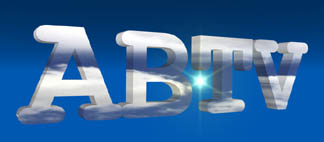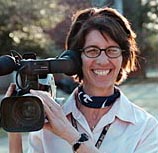"ROLL CALL! WHITE TEAM!! BLUE TEAM!! ORANGE TEAM," Dirck Halstead gleefully barks. Assembled to screen their second assignment at the Platypus Workshop, a room full of professional photojournalists prepare to be humbled before their peers. Grey Team leads off with piece about a grandpa at the football game. "We need a shot that shows that grandpa is actually in the stadium, watching the game! Who is that other person we hear in the interview? Why don't we see her? Who is this story really about? Is that the composition you really wanted for your interview?" Orange Team is next. Bowling. Most of the
elements are there. Wide-shot, close-up, action, (oops, we're missing the
reaction), insert, cutaway. Father Don Doll, SJ, of the Blue Team, introduces
a piece: "This video is about wrestling, and ballet. I was wrestling
with the camera while I tried to shoot a ballet class." Still shots, on
video, of dancers' feet and ankles slip through the frame. Faculty members
Dirck, Amy Turnley, Rolf Behrens, and Dick Swanson repeat the basics of
"shooting a sequence." The moments must have context. The close-up
of the foot can't be used without a wider shot of the dancer. The dancer
must be shot in a sequence which locates her in the studio, that shows
her face, that tells a story. The next team pleads, "For the following
two minutes, I didn't know the camera was rolling." "The mechanics of the
equipment and the shooting techniques will become automatic," workshop
instructor Rolf Behrens assures the group. "It becomes automatic, and frees
you to tell the story."
The White Team screened their story about the scenic department at a theater. They had shot the elements they needed to build a sequence. Later, the team took these techniques to another location: "And so we headed to La Bare, a male dance club in Oklahoma City, with visions of The Full Monty dancing in our heads," Dana Smillie wrote to me, from Cairo, after the workshop. "OK, Olga and I are Platypi so we restrained ourselves from screaming and shoving dollar bills into g-strings. ROUTINES! ROUTINES! Hold the shot! Shoot and Move! Action/Reaction! Wide-Medium-Tight! Beginning-Middle-End! Despite the obvious distractions, we remained pretty well focused-but most of all, we had fun." By "turning something into play", Dana took off a bit of the pressure to produce something brilliant, and when that stress is gone, the ideas and creative energy flow naturally. "Marco, you're in trouble," growled Dirck, after his team went AWOL, and reported back late. Marco Antonio Zaragoza had spent the afternoon with David Turnley, taping a most serene child in her ballet class. David had shot beautiful sequences of a girl who lacked the statuesque body and grace of other students, but had the composure of a Zen master. That night, Turnley screened his CNN show about the Dalai Lama. Two things struck me about David and his work. One, how well he had learned from his experience on his first shoot, and hit the ground running in Norman. The other, was his desire to learn. Here was a luminary in the world of photojournalism asking the group for feedback. David wants to tell stories that he cannot capture with still photos alone, and is willing to humbly shoot Platypus assignments, to further his video education. Others in the workshop shared this attitude. Edward Keating was very matter-of-fact
about his New York Times career, but very passionate about his love
of shooting. Wolfgang Achtner, a man who loves the news business and has
been in it quite some time, and Bob Heller, a New York film/video producer,
both went to Norman to open themselves to different directions midway through
successful careers. Bill Campbell arrived at the Workshop with a video
camera, and encouragement from CNN to learn how to tell wildlife and environmental
stories with it. He suffered the challenge of shooting a video story in
a Target Store, and did it with good grace and pretty good style. When
the faculty asked him to produce another one-minute project at Target,
he drew the line. "I'm not going back to Target!!" he announced several
times, until Dirck and Rolf finally relented. The last I heard, Bill's
team was creating a video essay on roadkill in Norman. It must have been
a "killer" piece, because Bill later signed a contract with CNN to produce
and shoot two wildlife programs.
Peter Turnley is a dedicated photojournalist, who sometimes just wants to have fun. His story about a stripper buying "a dress to take off" demonstrated his talent at engaging his viewers. Peter observes some incredible moments on his still assignments that he can't capture and sell as a still photo. He thinks that video will let him tell these stories. Judy Reich (age 38), and Lou Toman (age 62), of the Sun-Sentinel in Ft Lauderdale, Florida, plan to shoot video for their paper's webpage, and perhaps their cable TV outlet. I accompanied them on their mission to shoot a piece in the Children's Library. When I asked Lou whether he'd feel comfortable doing the reporting, he explained, "I already do it." Lou shoots and sends digital photos every day to the paper. He isn't the least bit phased by technology-he embraces it as a new tool. "I'm never gonna retire," he said, "it feels too good when I work." Judy worked hard on accomplishing her video checklist at the library. "Am I crossing the line [of action?]" she stopped to consider several times. Her video was complete with close-ups, wide shots, and reverses. When she screened her footage, her shot of an infant who obligingly crawled out of frame, clearing the shot, caused the knowledgeable Platypi to cheer. The Platypus Workshop launched 30 still photographers into the world of video. Dick Swanson pointed out, "it's only the beginning of the possibilities...you've got a great head start because you've been doing this already." "We know their frame of reference," Dirck explained. "They have the comfort zone of other hybrids on their teams." The first Platypus class understood how
to make a good still photo. They were there to learn how to observe and
capture a bit of the world in moving images with sound. They found that
telling someone's story requires a lot more than framing a nice shot.
They've got the courage to learn something new, and the resources to find
an outlet for their work. Most of them have the desire and the means to
work solo. The Platypus connection gives them some extra support. And now
they have the tools to begin.
 Amy Bowers
|
